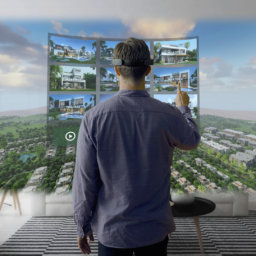Virtual reality is being dubbed as the future of brand experience. With the rapid adoption across various industries, the AR/VR market is expected to grow large – projected to reach $150 billion by 2020. Businesses are adopting VR to deliver beautiful and immersive brand experiences.
However, there’s no standard usage formula as each industry has its own needs and the technology caters to its demands in its specific environment.
In this article, we are going to list down top 6 industries where AR is being widely adopted and its impact is more meaningful.
1. Automotive
The automotive industry is using virtual reality in a range of areas. In fact, VR has completely changed the process of manufacturing, safety, and design as its realistic components enable designers and engineers to examine how the vehicle should perform and look without developing various frameworks.
In addition to this, VR is helping in conducting security prosecutions of vehicles by creating outside environment simulations. This is done without employing the time and energy required to run the actual tests.
A number of brands like Volvo, Ford, and Hyundai are utilizing VR to enhance their sales and designing process. All the vehicles are made accessible to the consumers who can now attempt everything from investigating vehicle features to test driving. As a result, VR is helping not only the vendors but also the customers.
2. Healthcare
VR has rapidly improved the healthcare practices. For example, realistic virtual environments and virtual human autonomy frameworks permit healthcare specialists to gain a vision without operating on an actual human body. This is beneficial for both students and experienced professionals who are performing high-risk and new procedures.
Primarily, VR is being used to train young doctors and healthcare professionals enabling them to offer unwavering patient care. Eventually, this interprets into fewer cases of carelessness and mismanagement, thus dropping liability insurance costs.
3. Construction and Skilled Trades
Despite the fact that displaying is important (like in healthcare and automotive VR training), gamification is the root of construction and skilled trades. VR offers a game-like, virtual environment for employees to practice utilizing tools, instead of touching any hardware.
For example, think about the program generated by the Campfire Union for tower crane machinists. This program engaged multi-player, cloud-based technology permitting two operators in diverse locations to simply co-ordinate tasks in the same virtual space.
Another advantage of VR training is that it saves you from spending extra money on materials for practice. These same programs are accessible for activities involving high risk i.e. forklifts operation. Lower-skilled trades like welding and painting are also utilizing VR, where labors can improve their skills prior to diving into work.
4. Aerospace Sector
The aerospace sector is gradually becoming extremely immersive as the VR technology allows teamwork during every step of developing and upholding procedures. This cooperative technology backs enhanced communication and recover understanding between employees functioning in various departments.
Manufacturers, engineers, and designers are now able to work together in order to develop quality products at a quicker speed utilizing visualization and product behavior testing.
In addition to this, virtual reality permits realistic visualization which empowers a strong relationship amongst various departments. This also promotes improved understanding and cohesion at all stages of development and design. As the communication gap has been sorted out, engineers, pilots, service workers and ground controllers can maintain competently.
5. Education Sector
Virtual Reality technology is mostly utilized for training objectives in the education industry – from mechanics to surgeons, yoke the benefits of VR. On the other hand, for the fresher students, VR in classroom contains virtual field trips, immersive games and some communicating sessions for children with special needs.
Such game-based and immersive experiences encourage students to become extremely advanced, as things which are not promising in the actual world, are possible in virtual reality. As a result, the virtual platform helps as a new tool that stimulates creative learning amongst students.
6. Retail Sector
With various industries taking advantage of Virtual Reality, retail is also experiencing an enormous bound by retaining VR. Consuming VR, retail showrooms can now display everything from numerous shades of a fabric to various furniture frameworks, without having to actually store these products on-site.
An added benefit to retailers comes with an intuition into customer behaviors, as customers get to test and try various products before purchasing.
Conclusion
This brief post gives you an idea of how various industries are using virtual environment and immersive media to improve processes, increase productivity and enhance their brand experiences.
If you aspire to use the very technology to your advantage but have very little or no technical expertise, we can help you with a customized AR/VR solution aimed at your specific business needs. If you want to build something great, contacting is the starting point – get in touch. Let’s do it for you!


